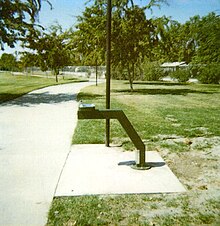For the World War II operation, see Eagle Project. For the jet powered car, see North American Eagle Project.
The Eagle Scout Service Project, or simply Eagle Project, is the opportunity for a Scout (Scouts, B.S.A.), or qualified Venturer or Sea Scout in the Boy Scouts of America (B.S.A.) to demonstrate leadership of others while performing a project for the benefit of their community. This is the culmination of the Scout's leadership training, and it requires a significant effort on his or her part. The project must benefit an organization other than the B.S.A., and it cannot be performed for an individual or a business or be commercial in nature. Completing an Eagle Project is a requirement in order for Scouts to attain the Eagle Scout rank.
Requirement

As a Life Scout, plan, develop, and give leadership to others in a service project helpful to any religious institution, any school, or your community. (The project must benefit an organization other than Boy Scouting.) The project plan must be approved by the organization benefiting from the effort, your Scoutmaster and troop committee, and the council or district before you start. You must use the Eagle Scout Leadership Service Project Workbook, in meeting this requirement.
— Boy Scout Handbook
A written plan must be submitted using the B.S.A. Eagle Scout Leadership Service Project Workbook and be pre-approved by the benefiting organization, the Scout Leader, the unit committee, and a district representative, before work on the project can begin. After the project is complete, the Scout updates the workbook where they discuss the methods in which they gave leadership, ways the plan may have had to change, and the benefits of the project to the community.

Examples of Eagle Projects include constructing park benches, running a blood drive, constructing a playground, building bat houses for a local park, refurbishing a room at a church or school, resetting stones at a cemetery, planting grass for erosion control, organizing a dinner, interviewing American veterans for the Library of Congress, distributing emergency medical information kits, and collecting necessities for the homeless.
History
The merit badges required for Eagles have been a requirement since the inception of the award. A Scout's "record of satisfactory service" with his troop was first added to the Eagle requirements in 1927. This changed in 1952 to "do your best to help in your home, school, church or synagogue, and community." This vague statement was refined to "plan, develop, and carry out a service project" in 1965.
In 1972 a leadership component "give leadership to others" was added.
Impact
The idea for a project may be an original one or the candidate may model their project on another Scout's. In either case, the Scout must plan, develop, and lead others in doing the project. There is no numerical minimum amount of time or requirement for time in which the project needs to be completed, but it must be enough to "demonstrate leadership." The exact implementation of requirements varies among districts and councils.
The rigorous nature of the required service project is a major step in the completion of the Eagle rank. Very often, the Eagle Project is what highlights the full impact of the Scouting program to the community at-large.
In 2012, the National Eagle Scout Association researched the number of volunteer hours spent on Eagle Projects and it came a total of more than 100 million hours of service. Each year, new Eagle Scouts are adding more than three million more hours.
See also
References
- "Eagle Scout Service Project How-to Manual". National Eagle Scout Association. Archived from the original on June 19, 2008. Retrieved July 26, 2007.
- ^ "Eagle Scout Leadership Service Project Workbook" (PDF). B.S.A. publication No. 512-927.
- The official source for the requirements shown in this article is: "Boy Scout Requirements" (2011 ed.). January 22, 2012. Archived from the original on January 22, 2012. — B.S.A. Supply No. 34765
- "Ask the Expert: Are blood drives and other drives acceptable Eagle projects?". October 3, 2018.
- "9.0.1.0 The Eagle Scout Rank Application Process". October 3, 2018.
- David Lowe, Eagle Scout on Flickr, Troop 170, Syosset, October 20, 2012
- "Eagle Scout Project Showcase". Boys Life. October 3, 2018.
- ^ Peterson, Robert (November–December 2002). "The Way It Was: Evolution of the Eagle Scout Award". Scouting. Archived from the original on June 25, 2006.
- Peterson, Robert (March–April 2000). "Last Step on the Trail to Eagle". Scouting.
- Elson, Martha (January 28, 2008). "Blind-school Scout earns Eagle rank". The Courier-Journal. Archived from the original on January 19, 2013. Retrieved January 29, 2008.
- Campbell, Julia (September 21, 2005). "Eagle Scout Project to Preserve HHS History". Hurricane Valley Journal. Archived from the original on May 19, 2007. Retrieved January 29, 2008.
- Phillippe, Jennae. "Eagle Scout project makes local history". Santa Clarita Valley Historical Society. Retrieved April 9, 2007.
- Malone, Michael (August 1, 2012). "A Century of Eagle Scouts". The Wall Street Journal. p. A13.
External links
- "National Eagle Scout Association".
- "Eagle Rank Application (for after project is finished)" (PDF). Archived from the original (PDF) on September 27, 2007.
- "Eagle Scouts". U.S. Scouting Service Project. Retrieved June 8, 2006.
- Smith, Randy. "Eagle Scout Leadership Service Project Planning Guide". Unofficial, but very helpful guide to planning and carrying out the project. Archived from the original on December 4, 2003.
- "Eagle Project Checklist & sample projects". Retrieved February 13, 2009.
- "Eagle Scout requirements & resources". MeritBadge.Org. Archived from the original on July 1, 2017. Retrieved February 12, 2009.